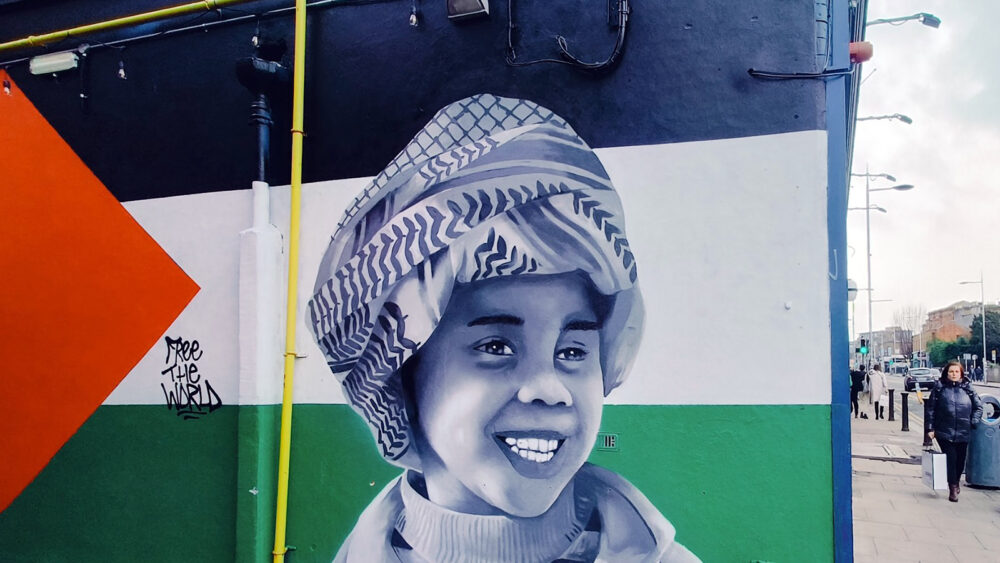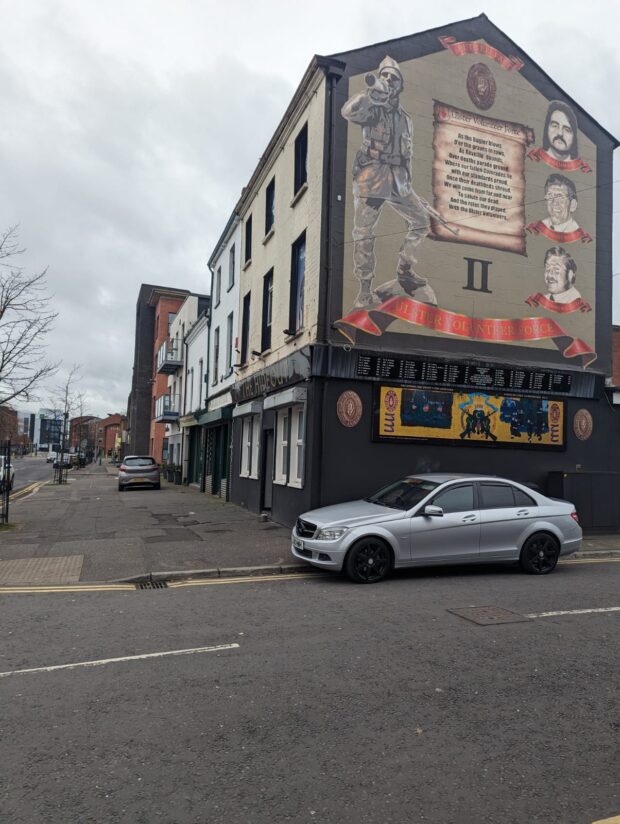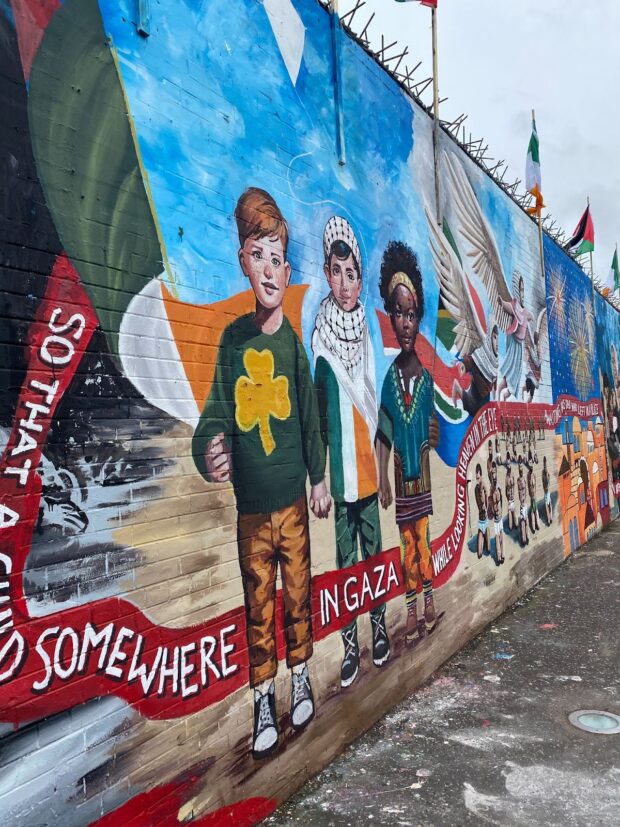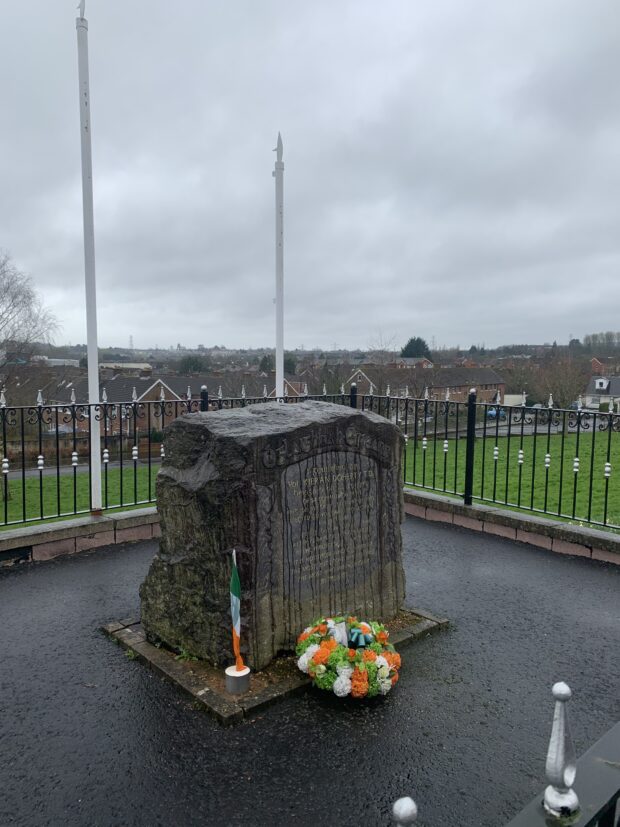An Afternoon of Katha
PLAINVIEW, N.Y. — The voice of the priest at the Sikh center grew louder on a recent Sunday afternoon as he delivered his final message.
“God doesn’t reside in the room; God resides within us,” he said.
As he spoke, the Guru Gobind Singh Sikh Center on Long Island was filled with approximately 200 people. After the children’s teachings had finished in the nearby school, it was time for adults to listen to the sermon, known to Sikhs as Katha.
The members of the congregation sat cross-legged on the soft red velvet carpet that covered the ground of the large space. Women, dressed in robes and colorful scarves, sat left. Men, with long beards and turbans, sat right. In the middle of the space stood an altar where the Guru Granth Sahib, the holy book, lies. At one side, a man, dressed in a white robe with an orange turban on the top of his head, delivered Katha.
Katha can also be described as the oral delivery of the teachings of Sikhism. It means “to describe and to help someone understand,” said Satleen Kaur, a 24-year-old law student at St. John’s University, translating the words of the head priest, Giani Amarjit Singh, aged 57. Even explaining the meaning of Katha is Katha, the head priest added. Every Friday and Sunday, the priests in the Plainview Gurdwara at 1065 Old Country Road share historical or everyday context through which the teachings can be understood.
On the walls hung several screens, on which a single line, appearing in the Guru Granth Sahib, was projected in Punjabi, accompanied by its phonetic and English translation. “This is the blessed opportunity of this human incarnation,” the screen read. This was the line the priest focused on.
“It’s about recognizing that God is within you too and to never forget God: the one that created the universe and the one that created you,” Kaur said. “There may be differences between us all, but at the end of the day God still resides in us all no matter what.”
The priest built up his sentences, sometimes he spoke with a bouldering voice. Other times, he spoke softer, with long pauses. He switched between Punjabi and English, but spoke Punjabi most of the time.
Harwinder Singh, 22, is a consultant for Mastercard and explained that the changes in language are to make Katha more accessible for those who do not speak Punjabi. Singh said that the style of every priest is different: some only use historical context to explain certain lines, others strictly use everyday examples.
The Guru Grant Sahib, the holy book, consists of poetry and music, but does not explain the meaning or historical background of the lines. Therefore, the contextualization of the holy scriptures must be done through scholars who have extensively researched the scriptures, Singh added. By spending an hour on every line, the readings are contextualized to understand the historical background and learn how to apply it to one's life.
The men and women listened quietly. Sometimes they nodded. Sometimes they exchanged whispers.
The teaching that day focused on the idea that God is within oneself. But in order to reach him, one must be attentive and intentional, Singh translated from the priest’s words. “If you want to do service, your mind should be with it,” Singh said. “If you do it for 5 minutes and go home, it does not work.” The decisions you make should not be just performative, Singh added. The priest used an example of a dirty house. In a dirty house, you cannot pay attention to what is holy within yourself, Singh translated.
After an hour of Katha, the people moved downstairs to do seva, the selfless service part of Sikhism. Both children and adults cooked, cleaned and served food. It is part of a learning process, said Kaur. When we left, the kitchen was almost spotless, acknowledging the words of the priest.
Observing the Akhand Path: A 48-Hour-Long Reading of Sikhism’s Holy Book at a Temple in Queens
NEW YORK — In the heart of Woodside, Queens, a pink building stands out against the gray January sky. The busy road outside contrasts the serenity inside the building. The Shri Guru Ravi Dass Temple is a Sikh temple, but here, next to praying to Guru Nanak, the founder of Sikhism, people pray for Guru Ravidas, a holy figure known in Sikhism for his rejection of the caste system. It is the only Ravi Dass temple in New York City, and it is located at 6101 Broadway in Woodside, Queens.
On a Saturday afternoon in January, the large space is filled with three men sitting in a circle on a blue and white carpet. A Sikh altar – a palki sahib – stands in the center. Paintings of holy figures decorate the walls. Downstairs, the sharp smell of onions tickles the eyes as people are doing seva, the ritual of selfless service to stand for equality, show humility and help others. Anyone who visits the temple may enjoy a meal made by the volunteers.
In the corner next to the large altar sits Amar Jipt Singh in a distinct space, wearing a yellow turban. His lips, almost hidden in his long white beard, move soundlessly as he shifts his head from left to right, reading the poetry that guides Sikhs in living a faithful life.
Today, January 27th, marks the second day of the 48-hour reading of the holy book, the Guru Granth Sahib. The ritual is executed in honor of major life events, such as marriages, funerals or births. The reading today is in honor of the birthday of Baba Deep Singh, a martyr from the 18th century who devoted his life to the teachings of Sikhism. The continuous, uninterrupted reading of the holy book is called the Akhand Path and is executed by a team of granthis, ceremonial readers, who each read for two hours.
When two women enter the temple and pray in front of Jipt Singh, he raises his voice and the rhythmic words of the Guru Granth Sahib become audible. As the women drop to their knees, Jipt Singh’s deep, low voice fills the room.
The prayer is not meant for Jipt Singh but is a way of paying respect to the holy book, Jipt Singh says after he finishes his reading shift. A young man has taken his place reading the book. “The Granth Sahib serves as a guide to human beings on how to live their life, to control desires and greediness,” he says. Jipt Singh, who is 72, was born in Moga, in India, but moved to New York in 2002. He recently retired from being a taxi driver and cashier at a gas station. With a cup of chai in his right hand, Jipt Singh describes what it means to read the Granth Sahib. “When you are reading and concentrating, you can get a happy peaceful mind,” Jipt Singh says. “But if you’re reading and you think about your car, then it means nothing.”
Not everyone is able to concentrate so deeply, he adds; sometimes his own mind also wanders off. But Jipt Singh says that is okay, as no one can judge what is going on in your mind. He will continue his reading in four hours, from 7-9 p.m., and from 1-3 a.m.
The young man who has taken the place of Jipt Singh continues muttering the Punjabi words written in the ancient book soundlessly. Tomorrow morning the last part of the reading will be done, and the Shri Guru Ravi Dass temple will be filled with 200-300 people who come together to sing, pray and eat, and celebrate the life of Baba Deep Singh.
For Irish Muslims, Eid al-Fitr is a ‘Mixture of Happiness and Sadness,’ As All Eyes on Gaza
DUBLIN (RNS) — The Islamic Cultural Centre of Ireland was decorated with festive lights on the inside and outside as Ali Selim was getting ready for the morning prayers on Wednesday (April 10), to celebrate the Muslim holy day of Eid al-Fitr. In the corners of the center, stations with sweets and tea and coffee were set up. Outside, smoke wafted out of white tents where vendors had gathered to sell food. Muslims from all over Dublin gathered after a night of celebrating Eid, which marks the end of Ramadan’s month of fasting, prayer and charity.
This year, however, the normally festive celebrations of Eid held a bitterness to them — as in Muslim communities around the world, the month of Ramadan had been shaped by the ongoing war in Gaza. It’s been an omnipresent topic in the mosque, said Selim, an Irish theologian and spokesperson for the Islamic Cultural Centre in Dublin.
“Eid is usually a day that is marked with happiness and joy,” Selim said. “But the mind can never be clear from the sadness over what is happening in Gaza.”
For six months, as the war between Israel and Hamas has raged in Gaza, Irish Muslims, some with family in Gaza, have lived in daily fear as the death toll in Gaza has mounted, surpassing 32,000, according to Gaza’s Ministry of Health.
“Every night we had to offer condolences to someone who lost a family member in Gaza,” Selim said. “Tomorrow (the morning after Eid), they will be with us. It will be very unique in the sense that it is sadness and rejoice at the same time.”
Selim had been hopeful as many around the world called for a cease-fire during Ramadan. “Everybody hoped that the crisis would be over,” he said of the war that began in the aftermath of the Hamas attacks on Israel Oct. 7, which left an estimated 1,200 Israelis and foreigners dead and 250 taken hostage in Gaza.

On March 25, the U.N. Security Council passed a resolution that demanded a cease-fire during Ramadan. On the same day, U.N. Secretary-General Antonio Guterres asked for a massive aid supply, with officials estimating that more than half a million people in Gaza are “one step away from famine.” No cease-fire was ever implemented during Ramadan.
Selim said that over the course of Ramadan, the Islamic Centre raised funds for people in Gaza and organized talks every night to heighten awareness of what is happening there. Several members of the congregation traveled to Gaza during Ramadan to deliver medical aid and returned with testimonies of the situation on the ground.
The purpose of Ramadan fasting, Selim said, is to “share the feeling with those who are deprived or marginalized.” This year, the “deprived or marginalized” on everyone’s mind are those in Gaza. Leaders of Muslim countries around the world made references to Gaza in their Ramadan announcements.
“There wasn’t a single day that Gaza was not part of our prayers,” Selim said.
It was not just Selim who focused his prayers on Gaza this Ramadan in Dublin, where just under half of Ireland’s more than 80,000 Muslims live.
“This Ramadan I think is more special than any Ramadan because of what’s happening in Gaza,” Lorraine O’Connor said. “We relate to what is happening to our brothers and sisters there.”

O’Connor is the founder and director of Muslim Sisters of Eire, a nonprofit organization in Dublin. With her organization, she provides a soup kitchen for the homeless of Dublin every week, provides educational training about Islam and aims for more dialogue between different religions. O’Connor was raised as a Catholic but converted to Islam in 2005.
Islam is the third-fastest-growing religion in Ireland, with the number of Muslims in Ireland growing 32% between 2016 and 2022.
Ramadan has been different from the start this year, said O’Connor.
Normally, she said, Ramadan prayers are for personal forgiveness, or for your family and friends. O’Connor said that she had been suffering from a chest problem and prayed for it to be over during the first evening of Ramadan. But doing so, she said that she immediately wanted to shift the focus of her prayer to the people in Gaza. “I felt a little bit selfish,” O’Connor said. “You want to turn your focus on the genocide that’s happening.”
The Muslim Sisters of Eire has organized several evenings this month to raise awareness and funds for people in Gaza, she said.
At Trinity College Dublin, Ruman Riaz of the Muslim Students Association has tried to raise awareness as well. Riaz is 23 and originally from Kashmir, India, a place where Muslims have had long-standing tensions with the Indian government. Riaz said he finds it frustrating that despite the efforts his organization and others are making, there are few changes.
“There is a sense of helplessness, you know, we can’t really do anything,” Riaz said. At the same time, the solidarity of Muslims for Gaza makes the community grow stronger, he said. “We all pray together for them, fundraise for them, and that just makes us even closer.”
The last 10 nights of Ramadan are believed to carry more reward than any day before, especially Laylat al-Qadr, the “Night of Power,” which this year fell on April 6. Muslims pray and ask for forgiveness the whole night of Laylat al-Qadr. Some do it privately at home and some attend congregations in mosques, Riaz explained.
“In mosques we usually end our prayers with a long supplication of asking God for forgiveness collectively,” Riaz said. “I’m pretty sure that every mosque will pray for Gaza.”
The faithful came to the Islamic Cultural Centre early Wednesday to sing the seven takbirs, or glorifications of God, until the time of the Eid prayer. The prayer was followed by a word from the imam, who began his Eid sermon by congratulating the community on finishing their fast. Then he turned to the continuing suffering in Gaza. Selim called his message “a mixture of happiness and sadness.”
“And it’s a mixture of thinking of those killed and those who are still threatened with death,” Selim said. “It’s a crazy situation.”

The Islamic Centre organized two prayer gatherings for the morning of Eid. Each attracted approximately 3,000 people, according to Selim. Selim added that, despite everything, there was still a festive mood.
“I saw somebody from Gaza this morning. I know he lost extended family members,” Selim said. The man said to Selim that some had managed to go back to where their houses had once been, and though they live in tents now, they have managed to connect water.
“Their message is ‘You can’t finish us, we will rebuild what they have destroyed,’” Selim said.
First published in Religion News Service.
Day Seven: History, Hope and Homecoming
BELFAST - The last day of our trip through Ireland started again with a traditional Irish breakfast in the Europa Hotel. The rainy, gray morning skies of Belfast contrasted the occasional green on the streets: a reminder that it was the eve of St. Patrick’s Day. Our class departed each our own way as our day was dedicated to individual reporting and some sightseeing.
Dina Katgara went to Best of 3, a live comedy show at the Black Box in Belfast, to report on comedians who weave the aftermath of the Troubles into comedy. It gave her a thought-provoking perspective into how people in Northern Ireland cope with stereotypes about religion, as well as trauma. There were some dark jokes that we have come to expect from Irish humor. One of the comedians held up his favorite toilet paper brand, Regina Blitz, and made a joke about cleaning up the blood from Bloody Sunday with it.
Renata Carlos Daou interviewed an asylum seeker from Iraq who works as a photojournalist in Belfast. They talked about his experience as a Muslim and immigrant in a country that still predominantly consists of both Catholics and Protestants.
Natalie Demaree and Genevieve Charles spent the day reporting in County Down at a St. Patrick’s Day Prayer pilgrimage. More than 150 people from all over the world attended the rainy two-mile walk from Saul Church, the first church in Ireland, to Down Cathedral, where St. Patrick’s tombstone is located. This pilgrimage has roots dating back to the 1950s and was led by a combined clergy of both Catholics and Protestants. The walk was followed by a church service at Down Cathedral where both Catholics and Protestants participated.
Other students explored Belfast and other areas in Northern Ireland. Daniel O’Connor wandered around the city and was intrigued by the Ulster Volunteer Force (UVF) paramilitary murals he stumbled upon at Donegall Pass in South Belfast. After wandering through a few blocks in the quiet neighborhood, O’Connor crossed the train tracks and soon realized he was back in a Catholic neighborhood, just by seeing a Palestinian flag and a Gaelic school.

Samuel Shepherd visited a recently completed mural on a peace wall — or, more accurately, a separation wall — in the predominantly Catholic area of Falls Road. It conveyed a poem by the late Palestinian poet Rafaat, who was killed in an Israeli airstrike in December. One section of the mural portrayed a child with a shamrock T-shirt, a child with a Palestinian keffiyeh and a girl with a South African flag holding hands in solidarity. On the other side of the wall, the West Belfast Cultural Society commissioned a placard honoring the close political friendship between the United Kingdom and Israel. While these etchings were physically close to each other on the wall, they were worlds apart in messaging.

Meanwhile, Katie Moody, Meghnad Bose and Trisha Mukherjee took a bus tour along the northern coast of the country. Driving by shining green pastures and a turquoise ocean rippling with waves, our reporters were overwhelmed by the beauty of Northern Ireland. They saw natural sites that appeared as settings in the popular HBO series "Game of Thrones." They also visited an Irish whiskey distillery and saw the outline of Scotland in the distance. Eventually, they arrived at the Giant’s Causeway, a seemingly magical area with basalt columns formed by an ancient volcanic eruption. An Irish legend tells another story, of a giant named Finn McCool who built a path to cross the Irish Sea to face the Scottish giant Benandonner, his rival. Benandonner, afraid of the meeting, ripped up the path and fled back to Scotland — leaving the scene as how it looks today. Despite the rain and wind, walking along the cliffs and the many stairs of the Giant’s Causeway was one of the highlights of their time in Ireland.
I dedicated my last day to interviewing people who experienced personal loss during the Troubles. It was part of an article I am writing about a law enacted by the British government in September. It says that Troubles-related inquests that are not finished by May 1 will be shut down. During my time in Derry and Belfast, I spoke to both loyalists and Republicans on their losses.
In the morning, I sat down in the Piano Bar of the Europa Hotel with Susanne McKerr, whose grandfather John was killed by the British Army during the Ballymurphy massacre. “Regardless of who the perpetrator was, what the incident was, what your identity is, the trauma is the same for us all,” said McKerr.
I then headed down to southwest Belfast, which is one of the Catholic hubs of the city. I interviewed Paul Crawford, whose father was killed by the UVF in 1974. In 1977, a man with UVF connections was arrested for the murder of his father, but it was only last year that Crawford received an acknowledgement that the UVF was responsible. After an hour of talking, Crawford showed me around the Catholic neighborhood, home to one of the hunger strikers during the Troubles.

During my journey back to the Europa Hotel, I crossed the “peace walls,” which flew Palestinian flags. I thought about the aftermath of the conflict in Northern Ireland and how it relates to ongoing conflict today — the intergenerational trauma, the mental health struggles and substance abuse problems individuals told me about. It made me contemplate: Do we as journalists report on the aftermath of conflict enough? What does it mean to go back to normal?
In the late afternoon, Dr. William Kitchen, a member of the political party Traditionalist Unionist Voice and an acquaintance of our guide Dr. Barbara McDade, came to the Europa Hotel to speak to some of us about the economics of Northern Ireland and the process of integration in the education system. Kitchen discussed the complexities of reaching a stable peace in Northern Ireland due to ongoing conflicting ideologies and economic conditions.
That evening, the class reunited for dinner at Deanes restaurant, where we were accompanied by Dr. Gladys Ganiel, who is a professor in the sociology of religion at Queen’s University Belfast. Ganiel talked about trends of religion and secularism in Ireland, after which we enjoyed our three-course meal in the private backroom of the restaurant.
During dinner we each shared our most significant moment from the trip, and we toasted our fellow classmates and faculty. Dr. McDade ended our evening by reading a poem by Seamus Heaney about war and peace:
Human beings suffer,
They torture one another,
They get hurt and get hard.
No poem or play or song
Can fully right a wrong
Inflicted and endured
…
History says, don’t hope
On this side of the grave.
But then, once in a lifetime
The longed-for tidal wave
Of justice can rise up,
And hope and history rhyme.
So hope for a great sea-change
On the far side of revenge.
Believe that further shore
Is reachable from here.
Believe in miracle
And cures and healing wells.
After a week traveling in Ireland and Northern Ireland, we learned about religious identity, conflict and the rocky path to reconciliation from a wide variety of speakers and local residents. The poem was a powerful reminder of the responsibility for us as journalists and storytellers to bear witness to other people’s stories and, while hoping for a “great sea-change” in the future, to keep on reaching for that further shore.
Edited by Samuel Eli Shepherd




